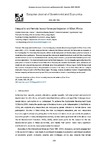Inequality and Female Labour Force Participation in West Africa

Ver/Abrir
Use este enlace para citar
http://hdl.handle.net/2183/27879
Excepto si se señala otra cosa, la licencia del ítem se describe como Atribución-NoComercial 4.0 Internacional (CC BY-NC 4.0)
Colecciones
Metadatos
Mostrar el registro completo del ítemTítulo
Inequality and Female Labour Force Participation in West AfricaFecha
2020-12-18Cita bibliográfica
Iheonu, C. O., Nwodo, O., Anaduaka, U., & Ekpo, U. (2020). Inequality and female labour force participation in West Africa. European Journal of Government and Economics, 9(3), 252-264. https://doi.org/10.17979/ejge.2020.9.3.6717
Resumen
[Abstract] This study examined the impact of income inequality on female labour force participation in West Africa for the period 2004 to 2016. The study employed the Gini coefficient, the Atkinson index and the Palma ratio as measures of income inequality. For robustness, the study also utilises female employment and female unemployment as measures of female labour force participation. The study employed the instrumental variable fixed effects model with Driscoll and Kraay standard errors to account for simultaneity/reverse causality, serial correlation, groupwise heteroskedasticity and cross-sectional dependence. The empirical results reveal that the three measures of income inequality significantly reduce the participation of women in the labour force in West Africa. The study also revealed that domestic credit, remittances and female education are positively associated with female labour force participation in the sub-region. Further findings reveal that economic development reduces the participation of women in the labour force in West Africa with the U-shaped feminisation theory not valid for the West African region. The study, however, revealed an inverted U-shaped relationship between inequality and female unemployment. Policy recommendations based on these findings are discussed.
Palabras clave
Female labour
Fixed effects
Inequality
Instrumental variables
West Africa
Fixed effects
Inequality
Instrumental variables
West Africa
Versión del editor
Derechos
Atribución-NoComercial 4.0 Internacional (CC BY-NC 4.0)
ISSN
2254-7088






